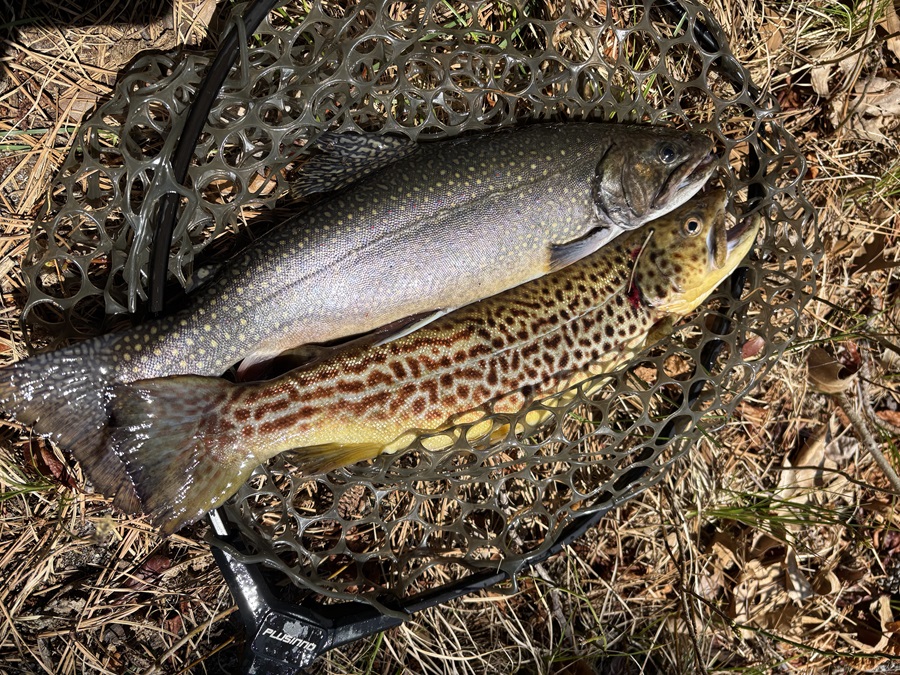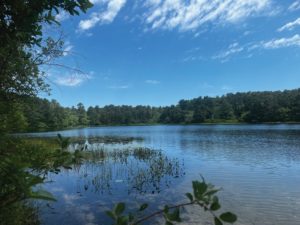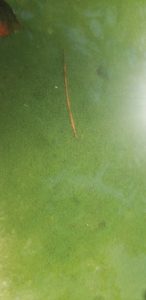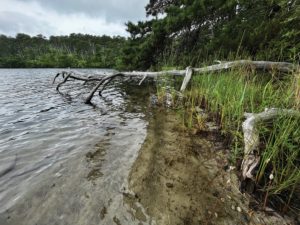On a balmy afternoon at the end of April, I spent a solitary hour casting from my favorite spot up the Herring River to see if any early bass had shown up. Alas, though the sunny spring afternoon was soul-satisfying on its own, there were no bass to be had.
I was on the way home to face the spring weeding when I remembered some recent gossip that Fish and Wildlife had stocked Gull Pond with very large trout. Still in my waders and not wanting to spend the rest of such a wonderful day on my hands and knees, I made a dash home for my flyrod and vest and headed for the pond.
As I waded in, stripping line from my reel and making false casts in preparation for my first, a frantic commotion erupted in the water perhaps 20 feet in front of me. Had it been the fall, when big trout and bass prey on Gull Pond’s herring fry, I would have known exactly what was happening. I thought, too, of adult herring: in their spring spawning mode, they swim frantically in ever-tightening circles over the shallows, creating almost exactly the kind of turmoil I was witnessing. But the alewives had yet to reach the pond.
The hubbub continued back and forth in front of me, now resembling the kind of disturbance a small seal rather than some kind of large fish might make. The mystery was resolved when, much to my dismay, a cormorant erupted from the pond holding a fat rainbow trout in its beak.

I felt a sudden, unexpected surge of anger: that damn bird was stealing one of my trout. I say my feelings were unexpected because I harbor no resentment toward sharks or seals feeding on stripers, nor tuna chasing the bluefish I’m fishing for. Yet this cormorant coming to my own town pond and stealing the fish my license and taxes are paying for had my blood boiling.
I watched the cormorant struggle to turn the fish head-down and tail-up so it could begin swallowing its meal. This involved much wing-thrashing as the two-pound trout dangling high above the cormorant’s body seemed to be on the verge of tipping the bird over. Finally, after a few adroit skyward tosses of its prey, the cormorant was able to grasp the fish head first. For several minutes the fish continued its epic battle, wiggling every inch of its way down the bird’s outstretched neck.
Then a third act ensued: the fat trout finally in its belly, the cormorant tried time and again to take flight — without success. As it began paddling its way to the center of the pond, my earlier urge to go home for my shotgun was replaced by the wish that I had taped the cormorant’s performance.
I began casting again, fully believing that every trout within a quarter mile would now be fleeing into the relative safety of deep water. Dejected by the fact that for the second time in the same picture-perfect day I was fishing fruitlessly, I headed home where I knew I would have no trouble finding weeds to pursue.
On the way to the garden, I reflected on how much I’ve come to rely on the natural world to guide my fishing. In fact, the cormorant notwithstanding, I tend to admire the ways wild creatures help me in my piscatorial pursuits. On the Herring River, for example, seeing large baitfish tells me that marauding stripers are around. And because it’s not always possible to see schools of herring or menhaden, I’ve learned to attend the ospreys’ searing calls and appreciate their impossibly steep dives. On the beach, I look for the presence of seals, which inevitably cluster just offshore to feed on the same baitfish stripers and bluefish consume. Sure, they’ll consume a striper or blue if given the chance, but I don’t see them as greedy competitors, the way I had the cormorant. They’re more like brothers-in-arms, fellow predators chasing the same prey.
Yet back at Gull Pond several days later, I found myself carefully scanning the water for signs of more undesirable cormorants. A short way down the shore I saw another waterfowl, a large and elegant white swan, slowly paddling the shore for beds of newly sprouted pond grass. How would I view the swan, I thought, if it, too, were a trout-eater?
I was mulling the question when I saw the sleek black neck of a cormorant rise quietly behind the swan before silently submerging to continue its hunt.
Seeing both birds, each elegant in its own way, made my cormorant aversion seem silly. Before the advent of fish-finding sonar, the cormorants off Race Point and the Pamet showed us where striper-and-bluefish-loving sand eels were schooling. It occurred to me that cormorants, though able to dive deep, prefer hunting in the shallows. Seeing a cormorant near the shore might actually be a useful sign that trout were feeding within casting range.
When I was a young man struggling to define who I was in the world, bringing fish to the table helped me see myself as a capable person. Fishing was sport but also a contest with the natural world. I might sometimes be bested by other fishermen or by the fish that got away, but my ignorance of nature was my main adversary, the thing that kept me from catching the fish of my dreams.
The more I learned about nature, the better I became as a fisherman. Fishing gradually became something other than a way to prove my worth with larger or more numerous fish. It became a way to be more intimate with a world in which fish play just a small part. It’s a world in which even a trout-stealing cormorant has something to offer.




